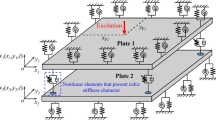Abstract
The free vibration of laminated composite plates on elastic foundations is examined by using a refined hyperbolic shear deformation theory. This theory is based on the assumption that the transverse displacements consist of bending and shear components where the bending components do not contribute to shear forces, and likewise, the shear components do not contribute to bending moments. The most interesting feature of this theory is that it allows for parabolic distributions of transverse shear stresses across the plate thickness and satisfies the conditions of zero shear stresses at the top and bottom surfaces of the plate without using shear correction factors. The number of independent unknowns in the present theory is four, as against five in other shear deformation theories. In the analysis, the foundation is modeled as a two-parameter Pasternak-type foundation, or as a Winkler-type one if the second foundation parameter is zero. The equation of motion for simply supported thick laminated rectangular plates resting on an elastic foundation is obtained through the use of Hamilton’s principle. The numerical results found in the present analysis for free the vibration of cross-ply laminated plates on elastic foundations are presented and compared with those available in the literature. The theory proposed is not only accurate, but also efficient in predicting the natural frequencies of laminated composite plates.


Similar content being viewed by others
References
R. D. Mindlin, “Influence of rotary inertia and shear on flexural motions of isotropic, elastic plates,” J. of Appl. Mechanics, 18, 31-38 (1951).
Y. Stavski, “On the theory of symmetrically heterogeneous plates having the same thickness variation of the elastic moduli,” Topics in Applied Mechanics. American Elsevier, N. Y., 105 (1965),
P. C Yang, C. H. Norris, and Y. Stavsky, “Elastic wave propagation in heterogeneous plates,” Int. J. of Solids and Structure, 2, 665-684 (1966).
S. Srinivas and A. K. Rao, “Bending, vibration and buckling of simply supported thick orthotropic rectangular plates and laminates,” Int. J. of Solids and Structures, 6, 1463-1481 (1970).
J. M. Whitney and C. T. Sun, “A higher-order theory for extensional motion of laminated composites,” J. of Sound and Vibration, 30, 85-97 (1973).
C. W. Bert, “Structure design and analysis: Part I,” in: C. C. Chamis (Ed.), Analysis of Plates. Academic Press, N. Y. (Chapter 4), (1974).
J. M. Whitney and N. J. Pagano, “Shear deformation in heterogeneous anisotropic plates,” J. of Appl. Mechanics, 37, 1031-1036 (1970).
R. C. Fortier and J. N. Rossettos, “On the vibration of shear-deformable curved anisotropic composite plates,” J. of Appl. Mechanics, 40, 299-301 (1973).
P. K., Shinha and A. K. Rath, “Vibration and buckling of cross-ply laminated circular cylindrical panels,” Aeronautical Quarterly, 26, 211-218 (1975).
C. W. Bert and, T. L. C. Chen, “Effect of shear deformation on vibration of antisymmetric angle-ply laminated rectangular plates,” Int. J. of Solids and Structure, 14, 465-473 (1978).
A. K. Noor, “Free vibrations of multilayered composite plates,” AIAA J, 11, 1038-1039 (1973).
J. N. Reddy, “Free vibration of antisymmetric angle-ply laminated plates including transverse shear deformation by the finite element method,” J. of Sound and Vibration, 66 (4), 565-576 (1979).
J. N. Reddy, “A simple higher-order theory for laminated composite plates,” ASME J Appl. Mech., 51, 745-752 (1984).
J. N. Reddy and A. A. Khdeir, “Buckling and vibration of laminated composite plates using various plate theories,” AIAAJ, 27(12), 1808-1817 (1989).
C. A. Shankara and N. G. Iyengar, “A C0 element for the free vibration analysis of laminated composite plates,” J. of Sound and Vibration, 191 (5), 721-738 (1996).
A. A. Khdeir and J. N. Reddy, “Free vibration of laminated composite plates using second-order shear deformation theory,” Compos. Struct., 71, 617-626 (1999).
B. N. Singh, D. Yadav, and N. G. R. Iyengar, “Natural frequencies of composite plates with random material properties using higher-order shear deformation theory,” Int. J. of Mechanical Sci., 43, 2193-2214 (2001).
M. Rastgaar, Agaah, M. Mahinfalah, and G. Nakhaie Jazar, “Natural frequencies of laminated composite plates using third-order shear deformation theory,” Composite Structures, 72, 273-279 (2006).
M. Şimşek, “Vibration analysis of a functionally graded beam under a moving mass by using different beam theories,” Compos. Struct., 92, 904-917 (2010).
M. Şimşek, “Fundamental frequency analysis of functionally graded beams by using different higher-order beam theories,” Nuclear Engineering and Design, 240, 697-705 (2010).
H. Matsunaga, “Stress analysis of functionally graded plates subjected to thermal and mechanical loadings,” Compos. Struct., 87, 344-357 (2009).
J. L. Mantari, A. S. Oktem, and C. Guedes Soares, “A new trigonometric shear deformation theory for isotropic, laminated composite and sandwich plates,” Int. J. of Solids and Structures, 49, 43-53 (2012).
J. N. Reddy, Mechanics of Laminated Composite Plate: Theory and Analysis, N. Y.: CRC Press, 1997.
M. Karama, K. S. Afaq, and S. Mistou, “Mechanical behavior of laminated composite beam by the new multi-layered laminated composite structures model with transverse shear stress continuity,” Int. J. Solids and Structures, 40, 1525-1546 (2003).
M. Touratier, “An efficient standard plate theory,” Int. J. Eng. Sci., 29, 901-916 (1991).
H. Ait Atmane, A. Tounsi, I. Mechab, and E. A. Adda Bedia, “Free vibration analysis of functionally graded plates resting on Winkler-Pasternak elastic foundations using a new shear deformation theory,” Int. J. Mech. Mater. Des., 6 (2), 113-121 (2010).
H. Akhavan, Sh. Hosseini Hashemi, H. Rokni Damavandi Taher, A. Alibeigloo, and Sh. Vahabi, “Exact solutions for rectangular Mindlin plates under in-plane loads resting on Pasternak elastic foundation. Part II: Frequency analysis,” Computational Materials Sci., 44, 951-961 (2009).
Author information
Authors and Affiliations
Corresponding author
Additional information
Russian translation published in Mekhanika Kompozitnykh Materialov, Vol. 49, No. 6, pp. 943-958, November-December, 2013.
Rights and permissions
About this article
Cite this article
Nedri, K., El Meiche, N. & Tounsi, A. Free Vibration Analysis of Laminated Composite Plates Resting on Elastic Foundations by Using a Refined Hyperbolic Shear Deformation Theory. Mech Compos Mater 49, 629–640 (2014). https://doi.org/10.1007/s11029-013-9379-6
Received:
Published:
Issue Date:
DOI: https://doi.org/10.1007/s11029-013-9379-6




